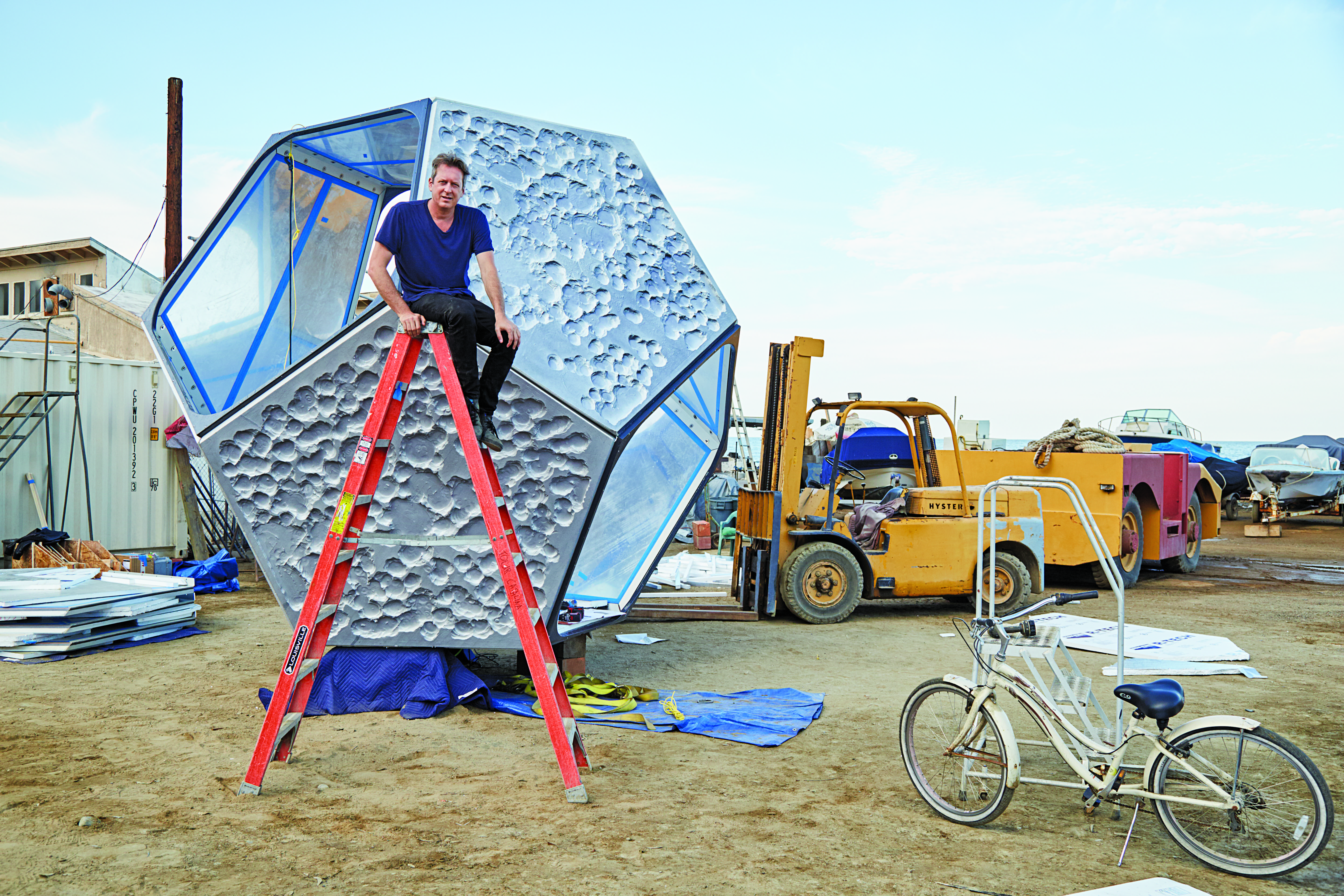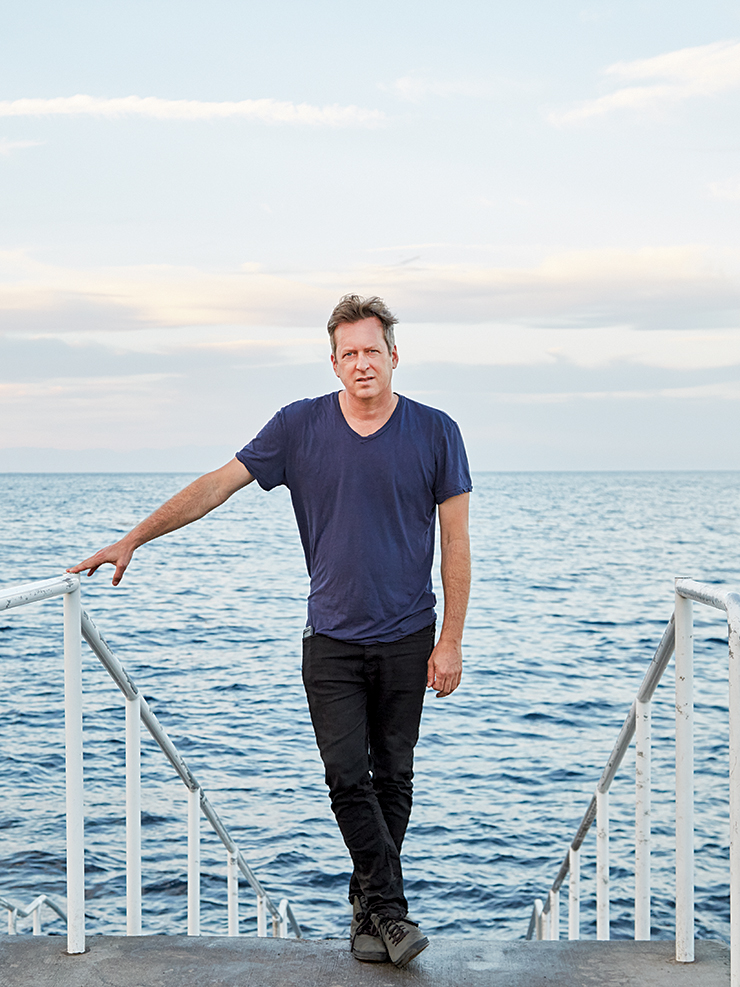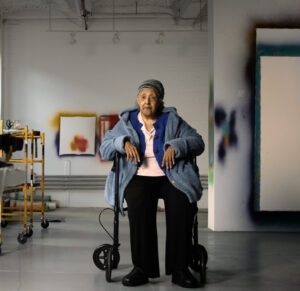
I’m on a boat with Doug Aitken—a high-speed catamaran zipping out to sea from the Port of Long Beach—when a rainbow of colored flags waving atop the old Catalina Casino comes into view. Built in 1929 by chewing gum magnate William Wrigley, Jr., who took a controlling stake in Santa Catalina Island a decade prior, the Sumner Spaulding-designed movie-theater-cum-ballroom—an Art Deco meeting place (or “casino”) that was never used for gambling—is where the Los Angeles-based artist intends to hold a 24-hour happening on January 14. Chock-full of lectures, performances, musical acts and enough late-night revelry to rival one of the stops on his 2013 cross-country railroad extravaganza, “Station to Station,” it will officially toast Underwater Pavilions, his ambitious new project in the marine protected areas just off the neighboring Avalon Bay.
“When you ask yourself what exists outside the actual museum and gallery system, there’s an interesting history and a lot of it is in the Southwest, which was a canvas in the ’60s and ’70s. But that’s a different generation, and that’s not the kind of work that I make,” says Aitken as we walk from the village’s main promenade to the circular casino en route to a barnacle-crusted stairwell that descends into the buoy-marked conservation zone. He got the idea while thinking about the expansive “film set” installation for his multimedia “Electric Earth” survey currently up at the Museum of Contemporary Art, Los Angeles. “I became really obsessed with the idea that the viewer isn’t asked to go someplace but to penetrate the ocean surface.”
At snorkeling depths of 10 to 20 feet and diving depths of 45 to 65 feet, the artist is mooring three of his reflective dodecahedron sculptures, each hewn from pentagonal marine-grade mirror, steel and recycled foam-and-boat resin aggregate panels, some painted a metallic silver, others in a blue-green ocean water gradient. These works are meant to attract aquatic leaf and divers who can swim around them, pass through one of their openings or simply take a siesta amidst the submarine splendor.
For Aitken, this project represents a “new method” for conceiving work, one that defies many of the Pop-leaning spectacles of his past. “The artwork I’ve been making is moving more in the direction of living systems and looking at the idea that an artwork is something that can continuously change,” he says, referencing his Sonic Pavilion, a circular glass structure built in 2009 on a hilltop at Brazil’s Centro de Arte Contemporânea Inhotim where underground microphones capture the earth’s vibrations inside a 202-meter-deep cavity. “When you’re underwater, audio travels differently and at such greater distances than on land, and the colors change. Warmer tints like red and yellow tend to disappear, so you’re working through a living lens, in a way.”

Standing at the base of the sea-sprayed stairwell as two divers ascend the steps, Aitken points to the approximate locations where each pavilion will be anchored, and explains that the sculptures will also be illuminated with white and red LED lights to allow a local marine institute to observe sea life.
Meanwhile, a website will be fed by six cameras (one inside each sculpture and one on the ocean floor beneath it) that were made for the project by Deep Ocean Exploration and Research (DOER), a marine consulting firm launched a quarter century ago by the esteemed marine biologist and National Geographic explorer-in-residence, Dr. Sylvia Earle. With the help of a live editing system Aitken will be able to move between perspectives “so you can push into any of those and have it be full-screen in real time,” he says, comparing the intended musicality of the experience to Marcel Duchamp’s Nude Descending a Staircase, No. 2. The artist is also partnering with Parley for the Oceans, an environmental organization that raises awareness about the threats of pollution, global warming and reef and sea life extinction.
“First it’s about raising awareness about the beauty of the oceans and then the horror that the oceans will be dead if we don’t turn around the way we’re doing business on this planet in the next 10 years,” says Parley founder Cyrill Gutsch, who has worked with many artists over the past five years and believes the impact will go far beyond the million people who visit Avalon every year. “The real stage for this artwork is the billion people who will see the film and website and video installations that travel to museums around the world. We’re going to send these beautiful pavilions all over the planet. They’re like an Olympic torch to reach people who don’t understand ocean health so we can come up with creative solutions and new product ideas and avoid more damage being done.” 
Aside from the cross-pollination of hard science, aesthetic wonder, environmental outreach and literal immersion, Aitken is most excited about the project’s portability, from Avalon to Asia and any applicable harbor in between. “If you were to look into the future, you might see what’s happening now with art as so radically conservative, when in fact, art can be absolutely anything,” says Aitken, pointing to how black smokers (hydrothermal vents on the ocean trenches) might inform how NASA scientists discover life on Jupiter and how that, and even the computer codes linking the two, can be viewed through an art lens. “It’s fascinating to look at this dialogue and realize it can all feed into a conceptual art system that creates conditions for new ways of seeing.”
After walking back toward the village we meet up with local diving legend Dr. Bill Bushing, who helped Aitken map the best spots to submerge the sculptures and is adept at hailing one of the island’s few cabs. (“They always say to me, ‘Slow down!’” Aitken jokes.) After a short drive around the bay we arrive at a private boat yard where Aitken’s team is assembling the pavilions—all of which fit, by design, in a single shipping container—just before golden hour approaches.
“Buckminster Fuller would be proud,” says Bushing, observing the 18-foot-tall geometries, whose look and feel might best be described as pockmarked surfboard. A team of DOER technicians is scrambling about the hardscrabble lot with power tools, hoisting the nautically engineered panels with forklifts. A firefighter drops by and snaps a round of photos that will surely get posted to social media—“There goes your scoop,” jokes Bushing—as a few locals cruise the rocky beach with their dogs between a dozen retired ships on dry docks and another dozen that are now submarine hotels for lobster on the sea cliff to the east. 
“One of the things about this that is most interesting to me is short-circuiting the idea of the preciousness of sculpture or a work of land art. Here it’s fluid in every way, and it’s moving from the speed of light on the ocean floor to a cafe in Berlin or a curator in London or a student in Tokyo,” says Aitken, laughing at the irony of a “Do Not Touch” sign he once encountered outside one of Richard Serra’s COR-TEN monoliths. If we truly only have a decade to act before the oceans die there really is no time for such delicate sensibilities by Aitken (or any other artist, for that matter). “I really don’t care what happens with these. If they get completely consumed with sea life, so much the better.”
While Aitken says Fuller wasn’t an inspiration for this project, I ask if he could envision underwater utopias—Fullerian cities almost—one day off the coast of, say, Palau or Crete, provided we still have living oceans to explore after the epic amount of time and effort it would take to permit, build and submerge such an endeavor. He just smiles, casually climbs inside the pilot model, and says, “I think that’s a great idea.”










 in your life?
in your life?

